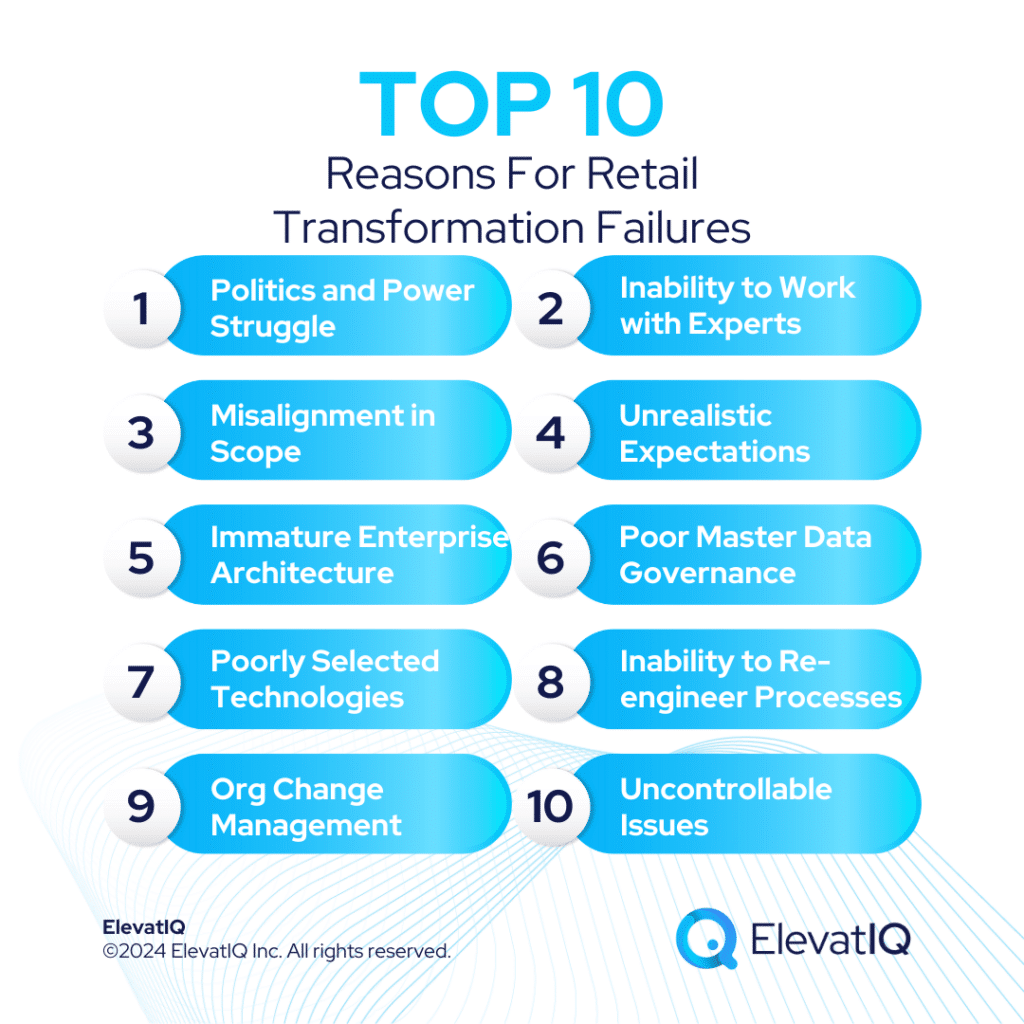Last Updated on March 10, 2025 by Sam Gupta
Most retailers understand the benefits of digital transformation. They are also good at crafting strategies for such initiatives. However, when it comes to execution and getting results with these initiatives, they struggle. And often result in retail transformation failure. But why?
The short answer is misalignment. Misalignment between strategy and execution. Misalignment between business and IT. Or misalignment between different departments. And these issues run so deep that even experts are likely to miss them.

Also, while departmental initiatives are easier, enterprise-level transformation initiatives require another level of expertise. The expertise in multi-disciplinary and cross-functional initiatives takes years to master. So unless you have done it a hundred times, it’s very likely that the first fewer attempts are likely to fire back. And while you might not fully appreciate the costs of consultants, having a team of advisors is absolutely critical for the success of the digital transformation. So, what are the top reasons for retail transformation failure?

10. Uncontrollable Issues
What are the major drivers for these issues? Inability to foresee issues due to the limited experience with retail transformation implementations. The excuse of “flagging” skillset gaps as uncontrollable issues. Limited experience in identifying core issues and creating a mitigation solution using technology or processes. The tendency to ignore uncontrollable issues despite being raised by technical teams and not funding POCs for further research and plan mitigation strategies.
As their name suggests, these issues are uncontrollable. But with experience, you will get better at spotting them and creating mitigation strategies around them. While they will always be unavoidable, the more time you spend in the strategy and planning phase, the fewer you are likely to encounter during the project and post-implementation phase.
9. Organizational Change Management
The core drivers for this issue? The tendency to believe that change management is a solution. For? Poor product design and operational performance issues. Inexperience in performing the root cause analysis of the underlying reasons. Trusting change management companies that believe that “change management” is all about the” touchy-feely” part of the transformation. The inability of change management consultants to work with the technical teams.
Organizational change management is often flagged as a symptom of most issues during retail transformation failure. But at times, the trigger for these issues could be completely different. For example, the overengineering of underlying systems or poorly coded interfaces might result in change management issues. Just like most sales performance issues are not always related to positioning and messaging, change management issues are not always related to the training and management aspect of change management. Identifying the root causes of the change management issues requires much deeper business and IT alignment. As well as an equal depth of knowledge in business and technology. Business or technology experts alone would not be enough to resolve these issues.
8. Inability to Re-engineer Processes (Aligned with the Capabilities of New Architecture)
What are the major drivers of this issue? Not enough experience in architecting business processes tailored to the business model. There is a lack of expertise in balancing usability issues, technical performance issues, and operational process implications. Inability to perform due diligence with the existing process and “perceived differentiators” that typically drive ad-hoc processes and custom solutions. There is a lack of ability to translate to-be vision into the process maps and transactional workflows for everyone to align stakeholders.
Each retail system is designed with certain assumptions in mind. Also, most standard systems are easier to integrate if they all comply with the data model of the enterprise software industry. Any deviations result in the overengineering of interfaces and process functions. This over-engineering further leads to the over-bloatedness of downstream components, resulting in a never-ending spiral. The only way to avoid overengineering is to have good enterprise architectural hygiene implemented throughout the process and systems.
7. Poorly Selected Technologies (Not Designed for Your Business Processes)
What are the root causes of this issue? Following the “checklist” approach for platform selection such as ERP, POS, OMS, and eCommerce.The tendency to follow a “binary” selection process: Choose a system as it is easier to customize or is cloud-native.The inability to perform deep gap analysis and identify the critical success factors that are likely to drive development and customization efforts. The tendency to listen to “experts” who might not have the technical expertise to create solutions for each gap.
Let’s face it. It’s very hard to master the skills that you might not be performing on a daily basis. Also, while the selection process may be perceived as following a checklist, there are always architectural and financial implications for each decision made. And so deep are these implications that you need many years of expertise with implementation – to be able to visualize these issues in your head. It is so deep that even experts might struggle to articulate them. Questioning their judgment typically leads to them conceding with “group-thinking, ” which fires back more than anyone would think. The easiest way to mitigate these issues is to let the experts do the job — without micro-managing them.
6. Poor Master Data Governance
What causes this issue? The inability to understand the fundamentals of the source of authority of each system. A misunderstanding that multiple sources of truth do not require identifying sources of truth. Inability to create a decision tree to resolve conflicts — and reconcile across sources. Inability to understand the implications of sharing master data across systems (and operational implications because of shared master data).

While most people understand the importance of good governance of master data, they underestimate the effort involved in getting it right. Not only does it require synergies among groups, but the processes and systems must also have the right controls in place. Otherwise, the poor governance of master data might lead to further overengineering of systems and processes. The only way to get the master data right is to have good master data governance processes with control across system boundaries — to ensure its cleanliness.
5. Immature Enterprise Architecture
What are the key variables that drive this lack of maturity? Thinking that enterprise architecture is only relevant to larger companies. Trusting that software packages are the solution to enterprise architecture. Not taking a holistic perspective on the architecture, including operations and finance. A tendency to downplay the importance of business, information, and process architecture.Inability to identify clear process boundaries for each system in the architecture and how that serves each functional component of the enterprise architecture.Over customization of the enterprise software or using too many poorly written bolt-ons.
Even larger companies struggle to adopt good enterprise architecture hygiene because of the perceived overlap between functions and the political and power struggles among groups. However, enterprise architecture is absolutely essential for enterprise-wide initiatives. The lack of good enterprise architecture hygiene often results in the over-bloatedness of departmental processes, which will throw off the master data and enterprise architecture. And sometimes, leading to catastrophic implications.
4. Unrealistic Expectations
The root cause of unrealistic expectations? Underestimating the efforts involved with projects that may lead to retail transformation failure. Asking technology vendors to find ways to “magically” reduce the efforts with the project. Asking your team to deliver 5-month’s worth of work in 2 months without compromises on scope or budget, Setting unrealistic dates without clear alignment from all teams involved.

The executives and companies do not have enough experience under their belt and have a tendency to underestimate the efforts involved. They often consider shortcuts or push their consultants or IT resources so much that they would have no choice but to take shortcuts. Shortcuts with documentation. Shortcuts with testing. Or shortcuts in producing good-quality code. These issues typically snowball into much bigger disruptions and maintenance backlogs, costing way more than a well-executed and planned implementation will. While there will always be cost-saving opportunities, try to perform a thorough analysis of each cost-saving strategy and its implications.
3. Misalignment in Scope
Not investing enough time in the discovery phase and planning at the surface level. Ignoring the advice from technical vendors despite their recommendations about the complexity of the project. Listening to salespeople with limited implementation experience and who might “lowball” to get a foot in the door. Underestimating the efforts involved with the software development process. Not investing enough time to create comprehensive test scripts and strategies.
Misalignment in scope is typically a symptom of poor planning or underestimating the efforts involved (or the costs) of such initiatives. Asking vendors to quote without a prior relationship will always result in a misalignment in scope. Regardless of their claims, they will always try to lowball in the hope of winning the business. Investing in the discovery and strategy, along with identifying technical and financial risks by doing POCs (during the strategy phase) will help with better scope management.
2. Inability to Work with Experts
No previous experience with retail transformations? Able to hire expensive consultants but only pretend to follow their recommendations? Do you not give consultants enough autonomy to drive initiatives? Not providing them enough resources to drive the initiatives? Are you unable to critically evaluate the skills and decisions made by experts? Not able to separate the signal from the noise? Inability to attract talent that, in turn, attracts more talent to make a winning team?
Working with experts is also an expertise that requires continuous improvement. Unless they have gone through many cycles and are experiencing them on a daily basis, they will not be able to relate with consultants. You need a team of consultants with multi-disciplinary expertise and depth in technology to be able to relate and work with IT resources.
1. Politics and Power Struggle
Misalignment among Individual functions with their expectations of the enterprise processes, data, and architecture? Conflict among functions in losing control of a dataset or process function? Covering up existing systems and investments and not willing to give them up in the new architecture? Are vendors trying to push their IPs in the hope of increasing their deal size? Are consulting companies trying to reduce the use of enterprise software with a pitch to reduce the software licensing fee?

No force impacts the outcome of retail transformation more than political pressures. And that’s why the skills of the CEO or sponsor are supercritical. Leaders who can read between the lines. Leaders who can separate signal from noise. And leaders who can empower consultants. This is way harder than anyone can ever imagine.
Final Words
Retail transformation initiatives fail because most companies have a tendency to underestimate the amount of effort required with these initiatives. Failing to invest in the strategy and planning phase, overpowering their consultants, and seeking discounts (and shortcuts).
The only way to be successful with these initiatives is to respect the process. And plan carefully. Get more expertise under your belt, and the higher chances you have with these transformation initiatives. But until you have that, don’t forget to listen to the experts truly.










